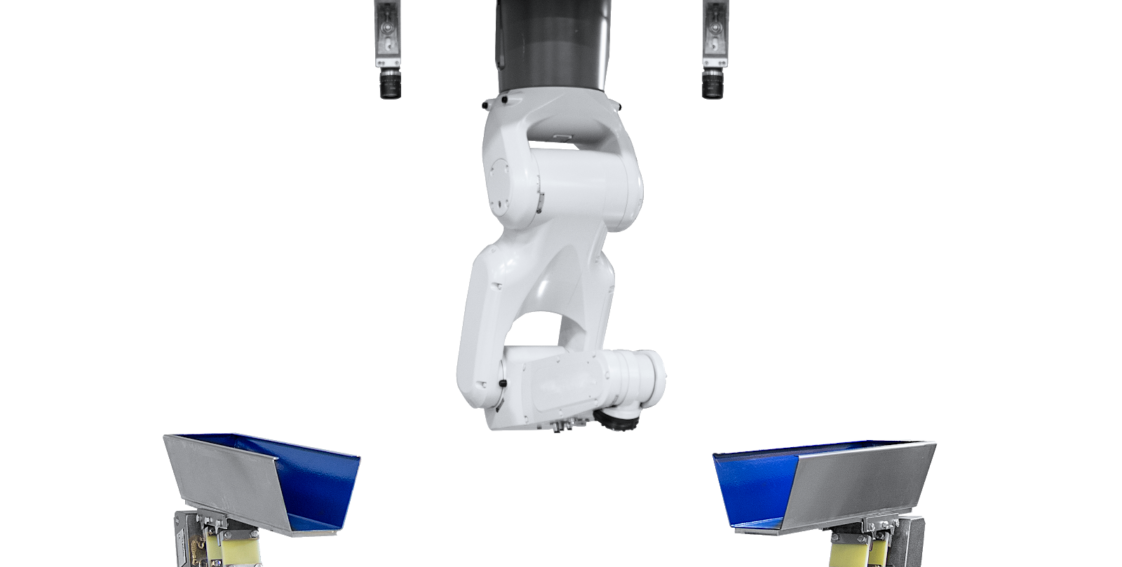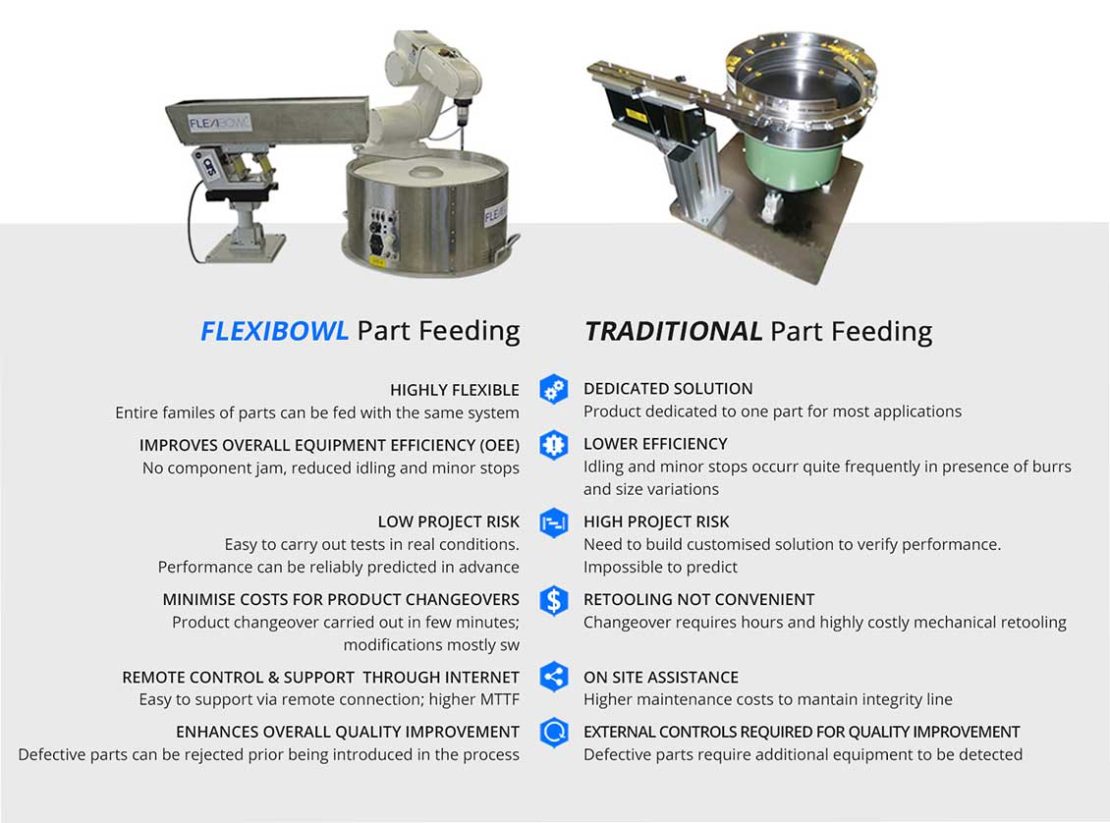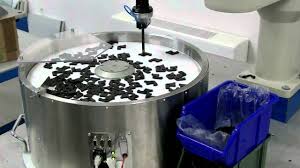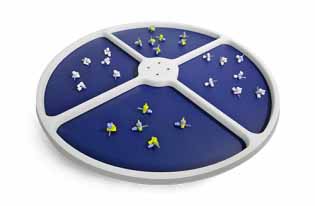
[ez-toc]
Part feeding systems are essential for any high-volume manufacturing application. However, there are some challenges with traditional systems.

First, traditional parts feeding systems are for the most part – part specific. They’re also expensive to implement, as many factories will need more than one feeding system depending on the variety of parts being processed.
One way to overcome these challenges is by implementing a flex-feeding system. Unlike traditional systems, they don’t rely on the part’s geometry and weight, making them suitable to handle a wide array of parts.
In general, if your factory processes parts of different sizes and geometries, then yes, you will most likely benefit from a flex-feeding system as an alternative.
Keep reading this guide to learn more about flex-feeding systems and how they work, how to select one, and what to consider before implementing them into your factory.
How Do Flex-Feeding Systems Work?
A flex-feeding system contains more than just a flex feeder. An entire system contains a bulk hopper, a flex feeder, a vision system, and a robot.
The bulk hopper stores all of the parts that need to be processed. Then, the parts from the hopper are dropped to the flex feeder surface where a robot and vision system identifies them in the correct orientation and picks them up. In some applications the vision system and robot can pick different parts mixed or the same parts in multiple orientations, which can help increase the pick rate.
The Different Types of Flexible Parts Feeders

Although all flex-feeding systems basically do the same thing, there are different types of flex feeders based on how they accomplish the part separation and reorientation within the system. The two primary designs of flex-feeding systems include conveyor and vibratory. Vibratory systems can also be split into two sub-categories: standard vibratory “spring magnet” systems and voice-coil based systems.
In general, conveyor mechanism-based feeders are best for simple reorientation tasks. In comparison, electromagnetic feeders are better suited for high volume reorienting applications especially voice coil based systems.
The type of flex feeder you will need largely depends on your application and the types of parts that are being processed and the application details such as pick rate and orientation.
Common Industry Applications
Flex-feeding systems are primarily used to increase both the speed and efficiency of bulk parts pick-and-place operations for loading/unloading applications.

Advantages of Flex-Feeding Systems
As previously mentioned, unlike traditional feeding systems, flex-feeding systems are capable of processing more than one type of part size and/or geometry. This capability aids in increasing the speed and efficiency of the automation. Another advantage is that, unlike traditional bowl-feeders, metal parts will not get jammed when they are being processed through a flex feeder as a result of wear. They are also much quieter compared to metal parts in a traditional vibratory bowl feeder.
Although the pros do outweigh the cons, there is one major consideration when deciding on a flex-feeding systems, it’s a higher level of technology. It is a robot and vision based system so you’ll need to be sure it’s something you can actually implement and support in your factory.
Challenges of Implementing Flex-Feeding Systems
The first challenge of implementing a flex-feeding system is that it must be properly evaluated for the specific application set. So, thoroughly evaluating your application with an expert in flex feeding is a must. The last challenge is that, because a flex-feeding system uses a broader range of technical skills, it’s important to ensure you can support it in your plant. Be sure to have a training plan in place as part of your implementation.
What to Consider Before Implementing a Flex-Feeding System
First, make sure that a flex-feeding system is the best option for you. If your application only requires processing one specific type of part and the geometry is simple, you might be better off with a traditional feeder. However, if you do process multiple types of parts, a flex-feeding system can help you increase speed and efficiency.
If you’ve already identified that a flex-feeding system is the best choice, and you have the support needed to implement and maintain it, you’ll still need to evaluate your application. The application evaluation will help you gain a better understanding of what type of system you actually need.
Before implementing any system, be sure you evaluate the following:
- Part Size: This is straightforward. Are you processing small, medium, or large items, or a variety of all three?
- Part Geometry: Are you processing parts with simple or complex geometries. For example, a coin is much simpler to orient than one side of a six-sided cube.
- Ideal Production/Pick Rate: How many parts do you want processed in one minute?
- Variety of Parts Being Processed: Does your application require processing multi-sized parts or parts with varying geometries?
- Percentage of Parts That Are Properly Oriented: How do your parts currently land on the feed deck when dropped? How many of them are correctly oriented?
- Material & Condition of Part: Evaluating this will help you determine the type of surface that you need your flex feeder to have.
- Bulk Hopper: Can your bulk hopper consistently “dribble the parts” out at a steady rate? If not, it may overflow the flex feeder.
In addition to the flex feeder, your entire vision system will need to be tested/evaluated to ensure it can correctly detect/locate the part and the part’s orientation.
If you need help evaluating your application, be sure to contact our experts at Schneider & Company. We not only offer flex-feeding solutions, but can also help you choose the one that’s best suited for your specific application. Read on to learn more about our solutions.
Schneider’s Solutions
We offer three flex-feeding solutions: EPSON’s Intelli-Flex, ARS FlexiBowl®, and RCM Bin Pick.
EPSON’s Intelli-Flex
The EPSON Intelli-Flex is an all-in-one solution that includes a voice-coil flex feeder with multi-axis vibration technology, a six-axis or SCARA robot arm, and an integrated vision system. It’s the perfect solution for applications with smaller parts that are harder to orient. The Intelli-Flex also features a smart auto-tuning setting, which uses built-in AI to adjust the parameters of the feeder to improve efficiency.
ARS FlexiBowl®
Our next solution is the ARS FlexiBowl®. This option is more suitable for small-to-medium part size applications with fairly simple reorientation needs. Instead of using vibratory methods to spread and move the parts, it utilizes a servo-based system equipped with an impulse generator.
It’s fitted with a doughnut-shaped conveyor type surface material and is very well-suited for feeding parts with different geometries and surfaces, including parts that are sticky or easily tangled. It’s also great for high-performance operations (over 80 parts-per-minute) and extreme environments.

Additionally, the ARS FlexiBowl® Flex Feeder features a lean, reliable design that keeps maintenance needs low, and you can integrate it with all types of vision systems and industrial robots.
RCM Bin Pick
Lastly, the RCM Bin Pick is an adaptation to our standard economical RCM robot cell. It’s specifically designed to handle larger parts too big for typical flex feeders and removes the parts from larger containers. Its distinctive design separates the robot vision part picking from the bulk parts extraction allowing it to be used for a wide range of applications.
Request a Consultation With Schneider & Co. Today
Do you need help selecting a flex-feeding system for your automation application? Turn to Schneider & Company. We’re a VAR distributor based in Michigan with a Tech Center full of equipment for evaluating applications and your automation needs. We support manufacturing, research & education and machine builders throughout North America. If you’re thinking about implementing a flex-feeding system into your factory, you can send your parts to us for a free evaluation.
Contact us today to request an evaluation, or to schedule a consultation with one of our experts.
